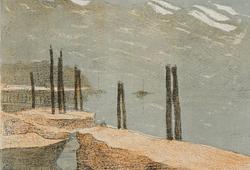Fabergé, An "Ice" brooch made of silver platinum, gold with rose-cut diamonds and rubies. Designed by Alma Pihl.
Made in the workshop of Albert Holmström.
Measurements 33 x 15 mm.
Total weight 2.7 g.
With original fitted case and certificate of authenticity.
Insignificant wear.
Provenance
Sonja Koreneff received the brooch in recognition of her work at the Nobel Hospital in St Petersburg during the First World War. The brooch has remained in the family ever since.
Exhibitions
"Unknown Fabergé: New finds and re-discoveries", The Museum of Russian Art, Minneapolis, October 8th 2016 - February 26th 2017.
Literature
Page 83 in the catalougue for the exhibition "Unknown Fabergé: New finds and re-discoveries", The Museum of Russian Art, Minneapolis, 8.10.2016 - 26.2.2017.
More information
There is a captivating story connected to this brooch. The younger sister of Emanuel Nobel, Marta Nobel-Oleinikoff (1881-1973), was a surgeon by education. This was not a usual occupation for a young woman of the upper circles during the early twentieth century. Marta, however, was a determined young person. At the age of twenty-four she married the military physician Georgii Pavlovich Oleinikoff, seventeen years her senior. He had inspired Marta in her studies in medicine. In 1909, Marta completed her studies, specializing in surgery, at the Medical Institute for Women in St. Petersburg.
At the outbreak of World War I, the Nobel family joined forces to assist the empire on home ground. A hospital for soldiers injured at the front was founded. The Nobel Hospital, as it was called, was accommodated in a building named The People’s House on Lesnoy Prospect, a house built for the convenience of the staff at the Nobel factories. It could without notable changes be turned into a hospital. Some one hundred and fifty patients were bedded in two large halls and in the library. The smaller rooms served ad offices, operation, x-ray, and baggage rooms. Young Marta Nobel-Oleinikoff was appointed chief physician of the hospital. Four dedicated young women surgeons worked with her. They were Vera Andreevna Moltianov, Masia Skarovna Freiberg, Alice Iakovlevna von Dehn (née Hoffmann), and Vera Petrovna Morell. All of these young women lacked experience and deeper knowledge of their profession, but they courageously took on this demanding work. The reason was the lack of skilled surgeons, all of whom had been called to the front lines. The nurses were recruited from Kauffmann Red Cross nurses’ home. Most of them had been hastily trained as “war sister”, but like the entire staff at the hospital, they were very much committed to their important work.
The young team, however, urgently needed help. Professor Zeidler, head of the Surgical Department of the Medical Institute for Women, allocated his closest assistant to help Marta Nobel-Oleinikoff. Assistance on organizing the practical work at the hospital was equally required. None was found in Petrograd, so on the recommendation of Professor Zeidler, a skilful head nurse at the Hospital of Surgery in Helsinki was contacted. She was Sonja Koreneff (1872–1960). Nurse Koreneff’s help was of great value. Nobel hospital got off to a flying start, specializing in bone fractures and after-treatments with medical gymnastics, as well as mud-and-massage baths, with very good results.
As a memento for her valuable consultation work, Sonja Koreneff received the beautiful snowflake brooch with a red cross formed in rubies. The gift was very well received, and her family cherished Sonja’s memory, as does the entire nursing corps in her native Finland. Ms. Koreneff subsequently founded an institution for educating nurses and ended her career as Head Nurse for the main hospital of Helsinki, the Maria Hospital.
Text Ulla Tillander-Godenhielm.
From the catalogue for the exhibition Unknown Fabergé: New finds and re-discoveries in 2016 at The Museum of Russian art in Minneapolis, USA. Page 82.









































